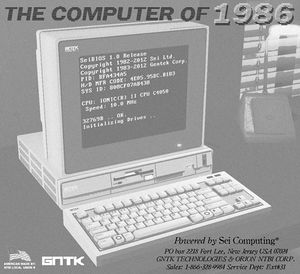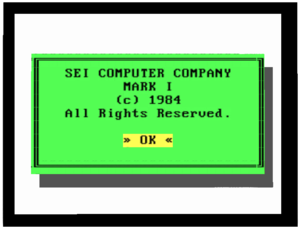Difference between revisions of "Mark 1"
imported>NelsonJenkins |
imported>NelsonJenkins |
||
| (8 intermediate revisions by the same user not shown) | |||
| Line 1: | Line 1: | ||
| − | The '''Mark I''' is a computer hardware platform in | + | The '''Mark 1''' (previously '''Mark I''') is a computer hardware platform in development by [[NBS]]. It is the first and only fully-functional graphical computer capable of operating entirely on LSL. |
[[File:COMPUTER_OF_1986_wiki.jpg|thumb|300px|right]] | [[File:COMPUTER_OF_1986_wiki.jpg|thumb|300px|right]] | ||
| + | [[File:Mk1-OriginalDisplay.png|thumb|300px|left]] | ||
==Origins== | ==Origins== | ||
| − | + | The Mark 1 was first spawned in December 2011 by [[Nelson Jenkins]] with assistance from [[Will Szymborska]]. The idea of an individual-character display was thrown around for years, but wasn't technically feasible until recently due to newer LSL functions and mesh construction possibilities. [[Adel Button]] assisted by designing the character display object, which was scripted in only a few hours late at night. The first design ever displayed on the Mark I display was a green SeiOS dialog box with a drop shadow. The casing and peripherals were made in the following weeks, along with the core of SeiOS. | |
| − | The Mark | ||
| − | |||
| − | |||
| − | |||
| − | |||
| − | |||
| − | |||
| − | |||
| − | |||
| − | |||
| − | |||
| − | |||
| − | |||
| − | |||
| − | |||
| − | |||
| − | |||
| − | |||
| − | |||
| − | + | Originally the display was going to be [[Media:Mk1-DisplayDesign.png|40x20 characters]], which would have been 50 prims land impact. However, the display was sized down to 32x15 characters, which reduced the land impact cost considerably. However, after [[Sei Computing]] was transferred to [[NBS]], the display driver was redesigned which allowed for 48x20 characters, as well as foreground and background colors for each character cell. The new display driver, named "TrueColor", also sharpened the display characters and added the capability for monochrome displays. This display driver was made possible by the use of an attachment for the display object, which also reduced the prim count of the computer dramatically. | |
| − | |||
| − | |||
| − | |||
| − | |||
| − | |||
| − | |||
| − | |||
| − | |||
| − | |||
| − | |||
| − | |||
| − | |||
| − | |||
| − | |||
| − | |||
| − | |||
| + | As of 2016, the Mark 1 is being redesigned with a new case and a new operating system. The operating system will implement a more adaptable program manager so that the computer operates much more realistically. | ||
| − | {{ | + | {{NBS}} |
Latest revision as of 22:33, 30 September 2016
The Mark 1 (previously Mark I) is a computer hardware platform in development by NBS. It is the first and only fully-functional graphical computer capable of operating entirely on LSL.
Origins
The Mark 1 was first spawned in December 2011 by Nelson Jenkins with assistance from Will Szymborska. The idea of an individual-character display was thrown around for years, but wasn't technically feasible until recently due to newer LSL functions and mesh construction possibilities. Adel Button assisted by designing the character display object, which was scripted in only a few hours late at night. The first design ever displayed on the Mark I display was a green SeiOS dialog box with a drop shadow. The casing and peripherals were made in the following weeks, along with the core of SeiOS.
Originally the display was going to be 40x20 characters, which would have been 50 prims land impact. However, the display was sized down to 32x15 characters, which reduced the land impact cost considerably. However, after Sei Computing was transferred to NBS, the display driver was redesigned which allowed for 48x20 characters, as well as foreground and background colors for each character cell. The new display driver, named "TrueColor", also sharpened the display characters and added the capability for monochrome displays. This display driver was made possible by the use of an attachment for the display object, which also reduced the prim count of the computer dramatically.
As of 2016, the Mark 1 is being redesigned with a new case and a new operating system. The operating system will implement a more adaptable program manager so that the computer operates much more realistically.
| ||||||||||

